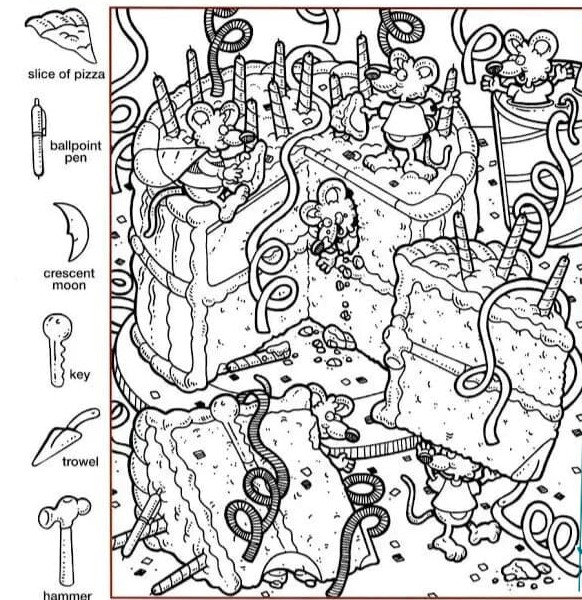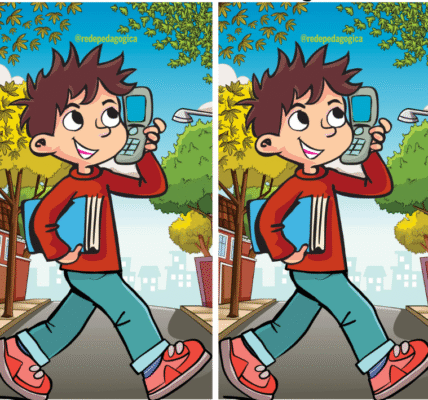The Ultimate Cake Party Hidden Object Challenge
Ready for a slice of fun that doubles as a brain teaser? In this vibrant illustration, a troop of mischievous mice scurry across giant cake wedges strewn with party streamers and crumbs. Your mission: uncover six cleverly concealed items—a slice of pizza, a ballpoint pen, a crescent moon, a key, a trowel, and a hammer—before the confetti settles. Let’s dive into this sugary spectacle, explore why hidden‑object puzzles tantalize our minds, and pick up pro tips to boost your spotting skills.

A Whimsical Party Scene Packed with Surprises
At first glance, you see oversized cake slices piled like stepping stones, each topped with birthday candles and playful mice nibbling frosting. But look closer: winding streamers weave in and out, hiding tools and trinkets in plain sight. It’s like attending a sugar‑coated fête where every swirl of icing might conceal your next discovery. This delightful chaos sets the stage for a puzzle that’s as much about celebration as it is about concentration.
Meet the Six Sneaky Hidden Objects
Before you jump in, here’s your scavenger‑hunt checklist:
- Slice of Pizza: Look for the classic triangular shape with pepperoni dots disguised among cake crumbs.
- Ballpoint Pen: Spot the slim cylinder and clicker tip camouflaged against the curly ribbon.
- Crescent Moon: Scan the cake’s edges and streamer loops for that familiar curved sliver.
- Key: Search for the toothed silhouette peeking from underneath frosting ridges or between layers.
- Trowel: This garden‑style tool often blends with the cake’s triangular facets—keep an eye on tiny shovel shapes.
- Hammer: Look for the T‑shaped head and handle tucked behind candle sticks or streamers.
Treat each item like a birthday gift hidden in a mountain of sweets—your excitement grows as you zero in on each one.

Why Hidden‑Object Puzzles Are Irresistible
Have you ever noticed how fulfilling it feels to spot something others miss? Hidden‑object puzzles trigger a mini dopamine surge with every find, creating an addictive “just one more” effect. They strike the perfect balance: complex enough to engage your brain but light enough to keep you smiling. It’s like a visual treasure hunt that transforms ordinary illustrations into a playground for your attention.
Brain Benefits: Sharpen Focus and Memory
Engaging with scenes like this isn’t just entertaining—it’s also a workout for your mind:
- Enhanced Visual Acuity: Tracking down tiny shapes improves your ability to notice fine details—in everyday life and on the road.
- Boosted Concentration: Sustained scanning trains your brain to filter distractions, increasing productivity later on.
- Improved Short‑Term Memory: Remembering which areas you’ve already checked reinforces your mental map of the image.
- Stress Relief: Focusing on a playful challenge helps quiet racing thoughts, delivering a mindful break.
Think of your brain as a muscle: every time you find that hidden key or pizza slice, you’re doing mental reps that build sharper observational skills.

Smart Strategies for Swift Discoveries
Feeling stuck? Here are some pro techniques to slice through the clutter:
- Divide and Conquer: Mentally split the illustration into zones—top left, top right, bottom left, bottom right—and tackle each section in turn.
- Color Cues: The ballpoint pen’s metal sheen or the key’s metallic glint will catch your eye if you scan for subtle shine contrasts against matte cake surfaces.
- Pattern Interruptions: Streamers flow in loops—spotting a straight edge or an unusual corner often signals a hidden object.
- Edge Hunting: Puzzle designers love tucking surprises along borders. Trace the cake’s perimeter and streamer edges for quick wins.
- Zoom and Shift: On-screen? Zoom in to reveal small tools hiding in frosting cracks. Printed? tilt or rotate the page to see new angles.
These tactics turn a random search into a methodical expedition, guiding you straight to those elusive objects.
Making It a Group Game
Puzzles shine when shared. Transform your solo challenge into a social event:
- Timed Relay: Set a two‑minute clock—who can mark the most objects before time runs out?
- Collaborative Map: Work together on a large printout, each person circling finds in a unique color.
- Story Challenge: After uncovering everything, invent a backstory: why did the mice stash a hammer in frosting? Let imagination run wild.
Group play adds laughter, friendly competition, and fresh eyes that might spot what you missed.

Digital vs. Print: Which Experience Reigns Supreme?
Your viewing platform influences your approach:
- On‑Screen Advantage: Pinch‑to‑zoom reveals minute details; digital markers let you flag finds without cluttering the image. Watch for glare on glossy screens, though—it can mask subtle shapes.
- Print Perks: Physically circling objects with pen or pencil offers tactile satisfaction. You can compare multiple copies side by side or pass them around a table, making it perfect for group sessions. Just be careful not to crease or smudge your masterpiece!
Pick the format that aligns with your style—both deliver the same sweet reward when you spot each object.
Beyond Fun: Educational Spin on Hidden‑Object Puzzles
Teachers and parents, take note: these puzzles are more than amusement. They nurture critical skills:
- Vocabulary Building: Label each found object—pizza slice, crescent moon, trowel—and discuss its real‑world use.
- Math Connection: Count candle sticks or compare the number of streamers to cake slices, turning play into a practical lesson.
- Creative Writing Prompt: After solving, ask kids to write a short story from a mouse’s perspective—why was the pen left behind?
- Art Appreciation: Study how the artist camouflaged items—line thickness, shading, color harmony—and inspire your own doodles.
By weaving learning into play, hidden‑object puzzles become a powerful educational tool.
When to Take a Break (and Why It Helps)
If you hit a wall, step away for a few minutes. A brief break clears mental clutter and lets your subconscious continue the hunt. Return with fresh eyes, and you’ll often spot objects that felt invisible before. Treat your brain like a marathon runner—it performs best with strategic rest.

Conclusion: Savor the Sweet Victory
This cake‑top celebration isn’t just about spotting a pizza slice or a hidden hammer—it’s a delightful voyage that sharpens your focus, sparks laughter, and kindles creativity. Whether you tackle it solo on your tablet, challenge friends over printed copies, or turn it into a classroom activity, the thrill of discovery never fades. So, grab your favorite snack, cue up some background tunes, and dive into the ultimate cake party hidden‑object challenge. Happy hunting!




